Window Treatment Terms and Definitions
What is a Window Treatment?
A window treatment is a custom-designed coverings installed over or around windows to elevate both the functionality and visual appeal of a space. The most common window treatments include Blinds, Shades, Shutters and Curtains or Drapes.
4 Main Categories of Window Treatments
In the world of window treatments, there are a lot of terms and phrases that get thrown around. Sometimes there are even multiple names for the same thing! It can get confusing!
The four main categories of window treatments are:
Blinds: Blinds are window coverings made of horizontal or vertical slats that can be adjusted to control light and privacy. Common types of blinds include Venetian blinds (horizontal slats), vertical blinds (vertical slats), and mini blinds (narrow horizontal slats).
Shades: Shades are window coverings made of a single piece of fabric or other material that can be raised or lowered to adjust light and privacy. They come in various styles, including roller shades, Roman shades, cellular shades (also known as honeycomb shades), and pleated shades.
Curtains and Drapes: Curtains and drapes are fabric window coverings that can be opened and closed horizontally. They come in a wide range of styles, fabrics, colors, and patterns. Curtains are typically lighter and more decorative, while drapes are heavier and often have lining to block light and provide insulation.
Shutters: Shutters are solid coverings typically made of wood, vinyl, or other materials, attached to the exterior or interior of windows. They consist of horizontal slats or panels that can be opened or closed to control light, privacy, and airflow. Shutters often add a decorative element to windows and can enhance the aesthetic appeal of a home.
Custom window treatments are carefully selected to help you manage natural light, protect your privacy, improve energy efficiency through added insulation, and tie together the overall look and feel of your interior design. Whether you're looking to refresh a single room or completely transform an entire property, our expert team works with you to create personalized solutions that complement your space and lifestyle.
At Gotcha Covered, we pride ourselves on being on the cutting edge of new advancements in the world of window treatments. But we also want to make it understandable, so that you, the consumer, feel comfortable discussing these various options with us. That is why we decided to take the opportunity to break down the lingo and give everyone an idea of what some of these words mean. For convenience, these are listed alphabetically to make them easier to find.
Need help picking the perfect window treatment for your home? We Gotcha Covered! Contact us now or find a Gotcha Covered location near you!
Common Window Treatment Terms
We know that navigating the world of custom window treatments can feel overwhelming. With so many styles, features, and operating systems, even the language itself can be confusing! We want you to feel confident and empowered in your decisions, so we've put together this list of key window treatment terminology to help demystify the process and better inform your search.
A
Alcove - a section of a wall or room that is set back from the remainder of the space. This can refer to the space created by bay and bow windows. This space can play an important part in determining the mounting options available for particular window treatments.
Angled Windows - windows that slant and create a trapezoidal or triangular shape. Typically these windows will follow the roof-line of the house. Due to the particular shape of these windows, determining the right window treatment options may prove to be a little more challenging.
Apron - window molding located below the window sill on a window frame.
Arched Windows - the bottom half is rectangular while the top portion is semicircular. Sometimes also called “radius windows.” This shape can prove to be a particular challenge when considering what window treatment options might work best. Luckily, the Gotcha Covered Design Team has years of experience when it comes to finding a solution to these challenging windows.
Ascot Valance - a valance with overlay ascots. The inside of the ascot if available with self or contrast fabric. It is mounted on a board with self-fabric dust cover and self or contrast fabric welting on the top edge. Additional scallops sections are offered with wider widths.
Austrian Curtains - elaborately pleated curtains with vertical cords spaced evenly across so that when raised, the curtain gathers together. A great example is a theater curtain on a stage that opens upwards.

Awning Windows - hinged at the top to allow the window to be opened upward and outward. Careful consideration must be taken into account when deciding on window treatment options to allow this window to maintain full functionality.
B
Balloon Shades - decorative shades that are gathered up higher on either side while the bottom drapes loosely in between.
Balloon Valance - a top treatment that is gathered on either end and drapes loosely in between. Can be used alone or in combination with other window treatments.
Bay Windows - a collection of three windows that are angled out to project from the primary wall of the structure. Typically consists of one main picture window in the middle with two other windows on either side. The mounting hardware placement can be particularly challenging when considering soft window treatment options.
Bishop Sleeves - long, side drapery panels that are gathered part of the way down to create a poof of material. Typically these treatments are designed to pool on the floor with the extra length of fabric to create a dramatic and elegant effect.
Blackout Lining - an additional layer to your drapes or shades that adds an extra level of light control to your window treatments. Great for rooms that you don’t want outside light seeping into such as home theater rooms and bedrooms. For more information about how your window treatments can help with light control, visit Get The Most Out Of Your Window Treatments This Summer.
Board Mounted Valances - a top treatment where the material is attached to a valance board and mounted above the window. Designed to specifically cover or enclose the window treatment hardware or to add décor to the window.

Bottom Rails - a piece of material that secures the ladders and cords to the bottom of the blind. It is typically made of wood, faux wood or metal depending on the product ordered.
Bottom Rail Tape Button - a small piece of plastic that snugly fits into small openings in the bottom rail. It secures the ladders into the bottom rail.
Bow Windows - a collection of four or five windows that are angled to project out from the primary wall. From the outside, the structure of the windows is curved to create a rounded appearance. The mounting hardware placement can be particularly challenging when considering soft window treatment options.
Box Bracket - installation brackets used to mount traditional horizontal blinds.
Box Pleat - a crisp, clean pleat that is made from two parallel creases on either side forming a raised portion in between.
Box-Pleated Valance - a fabric valance that hangs straight down from an L-shaped rod, with formal, stitched pleats.
Brackets - metal hardware that mounts into the wall, window frame, or ceiling and holds the rod or pole in place. Some are simply functional and are only there to serve their purpose, while others are more decorative and are meant to embellish the whole treatment.
Braided Ladder - braided polyester with rungs that the slats lay on top of. The ladders run vertically down the blind and hold the slats in place.
C
Café Curtains - can be lined or unlined, sill length or floor length. Can be hung halfway or a third of the way down from the top of the window to achieve the desired effect.
Cartridge Pleat - an elegant, modern style of pleat that is made from folds that allow the fabric to fall in neat, cylindrical curves.
Cascade - a top treatment of loose material that falls down on either side of the window in folds or gathers. Sometimes called a “jabot” or a “tail.”
Casement Windows - hinged on the side to allow the window to be opened like a door, swinging outward. Careful consideration must be taken into account when deciding on soft window treatment options to allow for this window to maintain full functionality.
Casing - an open-ended fabric sleeve where a curtain rod can be inserted. Sometimes also called a “rod pocket.”
Cathedral Window - windows that are typically seen in rooms with cathedral ceilings. The top of the window follows the slope of the ceiling. Many times the sloped top of the window is left bare.
Cellular Shades - a window treatment that uses two or more layers of fabric folded and then crisply pleated to create a pocket of insulating air between the window and your home. The cells help capture air creating a layer of insulation between the window and the rest of the room, making these versatile shades one of the most energy-efficient window treatment options available. These are sometimes also called Honeycomb Shades.
Center Draw - traversing drapes that open from the center of the window. Also called a “split draw.”
Center Stack Vertical Blinds - an operational option for vertical blinds where the headrail is designed to allow the treatment to open by drawing in the vanes from each side of the window to the center.
Center Support Bracket - used on wider blinds to help support the weight of the blind. This helps prevent sagging.
Circular Windows - round windows that resemble a porthole on a ship. Sometimes also called an “oculus.” Their unique shape can prove to be a particular challenge when considering window treatment options.
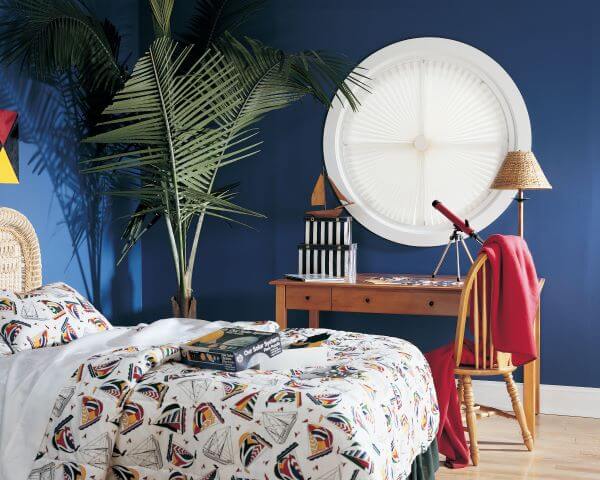
Classic Tab Valance - a valance with tabs at the top that are created with the header of the fabric in order to attach the treatment to a rod.
Clearance - the distance from the wall to the back of the window.
Clips - window treatment hardware attached to the fabric that can slide along the rod or pole. They can be decorated with ornamental shapes or motifs to add an extra design element. Sometimes also called “café clips” or “rings with clips.”
Cloth Tape - a decorative braided cloth available in different color options to replace standard cord ladders.
Color Blocking - when two fabrics are used in conjunction with each other to create a soft window treatment. Keep in mind that fabrics should be of similar weight to help it hang properly. Feel free to mix a solid with a patterned fabric and play around with proportions. Thirds and fifths are great ratios to start with.
COM - an acronym for “customer’s own materials” meaning a customer can choose their own fabrics to use to fabricate their soft window treatments.
Continuous Cord - this is a cord that comes out of the headrail and is attached to the bottom rail.
Contrast Fabric - the secondary color choice of a color-blocked soft window treatment. In some cases, there can be more than one contrast fabric which is labeled Contrast 1, Contrast 2, etc.
Control Length - the length of both the tilt and lift. This length is generally half the overall length of the blind.
Cord Lock - the component in the head rail of a horizontal product, which enables the blind to be raised or lowered and locked into any position.
Cord Tilt - a mechanism that operates with two cords instead of using a wand to tilt the blind.
Corner Windows - a window that occupies the corner of a structure. In some cases, the corner post of the window can be removed so that just the glass remains. The mounting hardware and maintaining full functionality can be particularly challenging when considering window treatment options.
Cornice - a decorative wooden top treatment mounted above a window that can be covered with fabric, paint, or wallpaper or can be designed and stained from an attractive piece of wood and remain uncovered. Sometimes these can also be upholstered, but they will not have any loose fabric hanging down.
Crown Molding - trim used for capping walls, pillars, and cabinets and used for cornice assembly around doors and window hoods. Can sometimes create an obstruction for certain window treatments that must be carefully considered before installation.
Curtain Headers - the top portion of the curtain through which the curtain is attached to the rod or curtain frame allowing it to hang a certain way, Different types of headers will create different looks for the curtain. Some of the most commonly used types of headers include pleated, rod pocket, tab top, grommet top, or flat/plain top. Sometimes also called “headings.”
Curtains - panels of fabric that can be short or long and typically come in pairs. Some are operable, meaning they open and close, and others are stationary and serve more of a decorative purpose.
Cut Length - the length of fabric needed for a window treatment including the heading and hem.
Cutout - a procedure where a section of the blind is cut out to allow clearance for obstacles that may be in the way of the blinds.
Cut Width - the width of fabric needed for a window treatment that includes the width required for the side seams.
D
Decorative Side Panels - stationary window treatments that can be used in pairs or multiples and are hung on either side of a window.
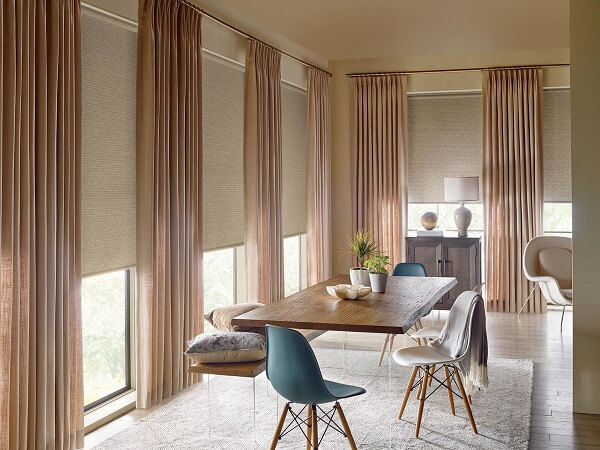
Decorative Sleeve - a sleeve of fabric that goes over a flat valance curtain rod. The header can be placed at the top only or at the top and bottom.
Decorative Soft Window Treatments - soft window treatments that do not perform a function. Typically, these treatments do not open or close, but stay in a fixed position. Some examples of decorative soft window treatments are stationary side panels, café curtains, and top treatments.
Double Fold Hem - as the name implies, the edge is folded twice and then hemmed. Typically used for the bottom edge of drapes and curtains to add a little extra weight to the bottom of the treatment to help it hang more evenly. The double fold also prevents the raw edge of the cut material from being seen.
Double Hung Windows - windows installed so that both the top and bottom sash are operable and can move up and down.
Double Rubs - a term that refers to how resistant a fabric is to abrasion by rubbing the piece of material over and over until it shows signs of wear.
Double Tracks - window treatment attachments mounted to the wall or ceiling above the window that use two separate tracks to allow different layers of the window treatment to be independently operable. Ideal for layered window treatments such as a ripplefold drapery paired with a sheer.
Double Width - refers to the finished width from selvage to selvage of two full widths sewn together. These will gather to approximately 40.”
Drapes - panels of fabric that can be the length of the window or floor length, Can be lined or unlined, and typically come in pairs. Some are operable, meaning they open and close, and others are stationary and serve more of a decorative purpose.
Drop Length - the length of a curtain or drape from the hanging system to the hem.
E
Edge Banding - adding a contrasting fabric to the edge of a soft window treatment. A great compliment for draperies, panels, Roman shades, and top treatments.
Empire Valance - a pleated swag-style valance. It has bell ascots that are self or contrast-lined. It is mounted on a board with a self-fabric dust cover and self or contrast welting on the top edge.
End Cap - caps that secure onto the bottom rail and head rail of metal and cellular shades. They are color-coordinated to match the window covering.
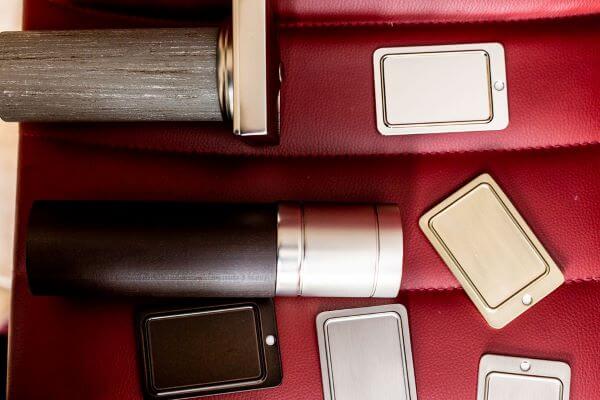
Extension Brackets - metal “L” brackets that are used in installing blinds that need to be extended out over the sill.
F
Fabric Grain - refers to the direction of the threads used in the weaving of a piece of fabric.
Face Fabric - the dominant fabric choice of a color-blocked soft window treatment.
Facing - an extra layer of fabric included within the treatment to strengthen the drape or curtain.
Festoon - a panel of fabric that is pulled up on either side by cords allowing the middle section to hang down in semicircular folds like a garland. Sometimes also called a “pull-up curtain.”
Finials - the end pieces that attach on each side of a rod or pole to help keep everything in place. They are both functional and decorative since they are visible on the finished product.

Finished Length - the final length of the window treatment after the heading and hem is complete.
Flat Fell Seam - an extra seam used to add strength to the original seam.
Flat Scallop Valance - a soft scalloped valance. Gussets can have self or contrast fabric and board mounted. Additional scalloped sections are added for wider widths.
French Door - a door with rectangular panes of glass extending the full length. They are usually hung with a pair of doors in one frame, with both doors opening outward.
French Seam - a flat seam that encloses the outer edge of a piece of fabric. Typically used on sheer or loosely woven fabrics.
Fullness - when talking about curtains and drapes, they can either be flat or have fullness. Fullness is the extra fabric used across the width of the drape that provides it with a richer look by increasing the visual depth of field and providing more light and sound absorption.
Functioning Soft Window Treatments - soft window treatments that perform a specific function such as providing light control or privacy. Typically, these window treatments must be operable - meaning that they are movable and can be opened or closed; raised or lowered. Some examples of functioning soft window treatments are traversing drapes, Roman shades, and blackout shades.
G
Goblet Pleats - a more formal pleat that makes each pleat look like a fluted glass.
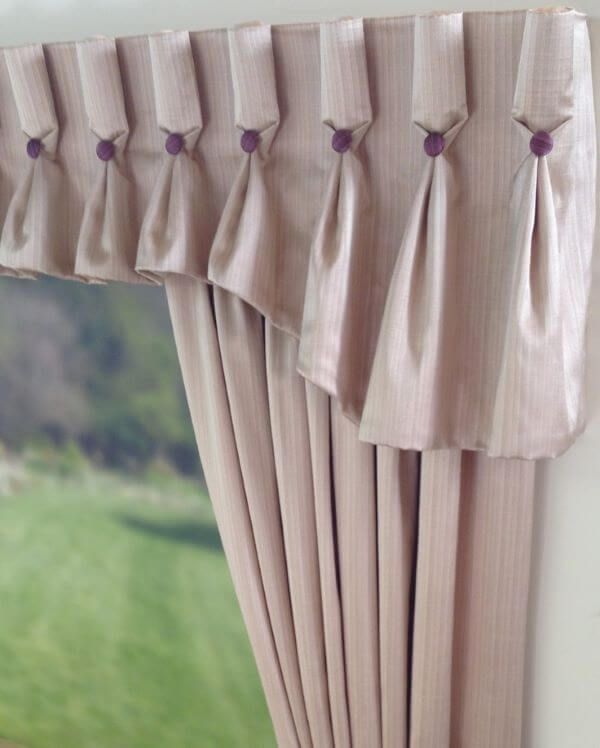
Grommet Top Curtains - curtain panels that have round, metal openings, called grommets that are evenly spaced along the top edge of the curtain where the rod or pole can be inserted.
H
Hardware - the pieces that mount your window treatment to the wall or window frame and allow it to hang and operate correctly. Typical hardware pieces include rods, rosettes, brackets, hooks, rings, clips, and finials.
Hard Window Treatments - window treatments that are made from a hard material such as wood, vinyl, metals, or other composite material. These will include blinds, shutters, and shades that are not made from fabric.
Head - the horizontal top portion of the window frame.
Heading - the top portion of the curtain through which the curtain is attached to the rod or curtain frame allowing it to hang a certain way, Different types of headings will create different looks for the curtain. Some of the most commonly used types of headings include pleated, rod pocket, tab top, grommet top, or flat/plain top. Sometimes also known as a “curtain header.”
Head Rail - a steel channel that houses all of the components that are needed to operate the window blinds.
Hold Down Brackets - typically used on outside mount applications and on door blinds. They secure the end of each side of the bottom rail to the outside of the window frame to prevent the blind from swaying.
Honeycomb Shades - a window treatment that uses two or more layers of fabric folded and then crisply pleated to create a pocket of insulating air between the window and your home. These honeycomb-shaped pockets help capture air creating a layer of insulation between the window and the rest of the room, making these versatile shades one of the most energy-efficient window treatment options available. These are sometimes also called cellular shades.
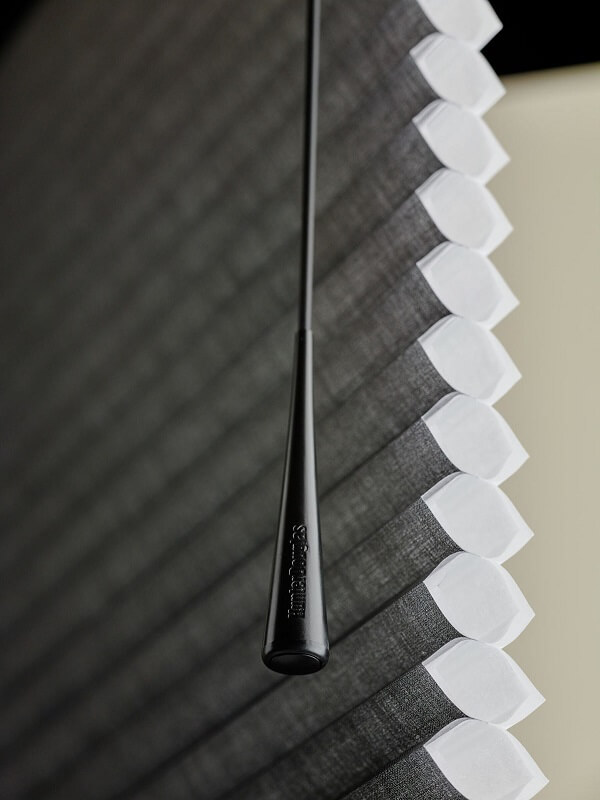
Hooks - window treatment hardware attachments that hold the material of the soft treatment to the rod or pole allowing them to hang in the desired position.
Horizontal Blinds - hard window treatments that use horizontal slats to cover a window. They typically have a lift system as well as a tilt system to create a variety of options for different levels of coverage making them very versatile. Horizontal blinds are typically available in materials such as metal, wood, vinyl, and faux wood options.
I
Inset Banding - a decorative trim that can be added to the leading edge of the drapery or panel.
Inside Mount - a window treatment installed inside the window frame rather than on the window casing. This is often abbreviated to “IM.”
Interlining Liner - a cotton flannel liner that is used between the main fabric and the liner fabric to add additional weight and protection. This is recommended for lightweight fabrics such as silk and silk blends. It can be used with standard, premium sateen, and water-repellent liners.
Inverted Box Pleat Valance - a tailored box pleated valance formed by two equal folds of fabric folded in towards the middle of the pleat at the center in front of the fabric.
Inverted Pleats - formed by bringing two equal, folded sides to a center point on the front of the material creating a box pleat on the inside.
J
Jabot - a top treatment of loose material that falls down on either side of the window in folds or gathers. Sometimes called a “cascade” or a “tail.”
Jambs - the vertical side portions of the window frame.
K
Kick Pleat Valance - a tailored box pleated valance that uses a type of inverted pleat that flares out towards the bottom.
L
Ladder Cords - the strings that attach the slats together in window blinds and allow for control options such as lift and lowering as well as tilt.
Ladder Grommets - metal clips that are compressed on the ends of the ladder at the bottom of the blind. They level the bottom rail and also secure the ladders.
Layered Window Treatments - using multiple window treatments to create a desired effect. Typically a combination of hard treatments and soft treatments, some of which provide a functional purpose and the others create a more decorative effect.
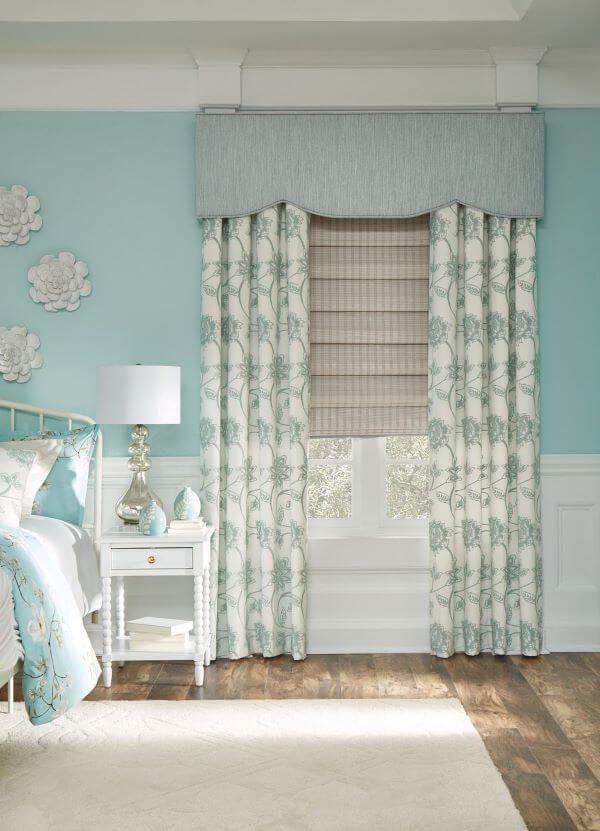
L-Brackets - brackets, shaped like an L, that are used during installation to extend the blind out over the sill. These are also called extension brackets.
Leading Edge - the edge of a curtain or drapery that is at the forefront of all movement. For example, for traversing drapes that are close to the center, then the innermost edge of the fabric would be considered the leading edge.
Left Stack - traversing drapes that open from the right side of the window and gather or “stack” on the left.
Left Stacking Vertical Blinds - an operational option for vertical blinds where the headrail is designed to allow the treatment to open from the right and stack to the left side of the window.
Lift Cord - the cord that is pulled to raise and lower the blind.
Light Gap - refers to the stripe of light that can shine through between the edge of a window treatment and the side of the window frame. These will naturally exist no matter how your window treatment is created to fit within the window unless the treatment is fitted within runners or tracks designed specifically for full black-out window treatments.
Lining - an extra layer of material that adds body and fullness to draperies and panels. Also protects the window treatment from exposure to light and heat thereby extending the lifespan. Also adds a professional, finished look to top treatments. Some of the most popular types of linings are blackout, thermal, and water-repellent liners.
London Valance - a valance that is gathered at the bottom hem with relaxed ends and stirrups. It has self or contrast stirrups and is board-mounted. Additional stirrups are added as the valance widens.
Loop Ladder - a braided ladder that is used on any routeless blind. The front and back of each ladder have loops that the cord is laced through.
Louvers - the adjustable horizontal slats in window shutters that tilt open or closed to admit light and allow a partial view outside, while maintaining a fair amount of privacy inside.
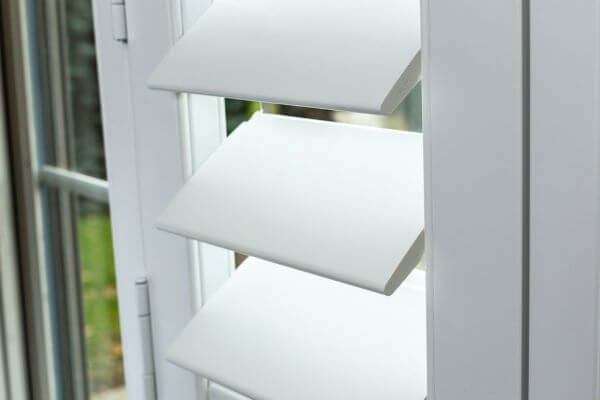
M
Medallions - window treatment hardware that is a decorative alternative to using a curtain rod. They are mounted directly to the wall above the window at evenly spaced intervals so that the material of the treatment can be draped over them and arranged. Also called “rosettes.”
Motorized Traversing Rods or Tracks - a functioning window treatment option that allows the treatment to be opened and closed without a cord or pulley, but instead by a motor. A great feature to add to any window treatment. To learn more about the benefits of motorization, check out this article 4 Common Misconceptions About Motorized Window Treatments.
Mullions - the vertical structure that separates panes of glass. These date back to when the only way to construct large sheets of glass was to combine smaller panes together using supportive pieces of wood. Now, mullions are primarily used for decorative purposes.
Muntins - intermediate upright bars of framing within a window providing critical structural support for the weight of the wall by ensuring the weight of the window is evenly distributed.
N
No Fold Swag Valance - a soft scalloped overlay valance. Adding a trim accent on the bottom edge is standard. It is mounted on a board with a self-fabric dust cover. Additional inserts are added for wider widths.
O
Obstructions - an object or architectural element within a space that must be worked around and can dictate placement and style options.
Oculus - a round window that resembles a porthole on a ship. Also called “circular windows.” The particular shape of these windows can prove to be a bit of a challenge when considering window treatment options.
One and a Half Width (1 ½ width) - refers to the finished width from selvage to selvage of one full width plus half of one width. These will gather to approximately 30.”
Opacity - in window treatments, the amount of light that is blocked out by a certain material. The lower the opacity of a type of fabric, the more light will be able to pass through. For example, sheers have very low opacity, while blackout shades have very high opacity.

Opaque - the quality of having 100% opacity meaning that no light can pass through the material.
Outside Mount - the installation of a window covering that goes on or beyond the window frame rather than within the window frame. This is often abbreviated to “OM.”
Overlap - the extra width allowance of drapes on a traversing rod that allows each side to slightly cross over in the middle.
P
Panel - one section of a drapery or curtain that is hemmed and can be lined or unlined.
Panel Tracks - runners that attach to the wall or ceiling allowing the fabric panels to slide open or closed across an opening.
Pencil Pleats - the traditional heading for curtains or valances that gathers the material together and allows you to expand or reduce the width to suit your needs.
Picture Window - large, fixed windows that are designed to maximize the view. They are non-operational, meaning they do not open, and have a low-profile frame.
Pinch Pleats - a narrow, short pleat used in the heading of a curtain or drape to control fullness. Typically used in groups, such as a triple pinch pleat which has three pleats gathered together in a group and then a space in between.
Plantation Shutters - window shutters with louvers that are over 2” wide.
Plastic Tape Roll - also known as a tape drum. The tape roll is typically metal in 1” and 2” products, nylon tape rolls are used for blinds with cotton tapes.
Pleat - a fold-in fabric or cloth that is held together by stitching at the top or on the side. With window treatments, there are typically 6 pleat styles that are available: cartridge pleat, four-finger pinch pleat, inverted pleat, box pleat, pinch pleat, and roll pleat.
Pleated Shades - shades made of accordion-pleated fabric, or sometimes even fibrous paper, which is raised and lowered with lift cords.
Pleated Style Traversing Drapes - operable drapes that use pleats to manage the length of the material, allowing it to gather together when the drapes are open or unfold when the drapes are closed. Some of the best pleat options for these drapes are pinch pleats or inverted pleats.
Pleated Valance - a valance that would be hung on a curtain rod or a decorative rod with rings. They are lined with standard lining with the exception of laces, sheers, and casement fabrics. Banding or trim can be available on the bottom edge.
Pleats - folds within a piece of fabric or tapestry that are held together by stitching on the top of the side and are used to control the fullness of the curtain or drape.
Pole Mounted Valances - material is attached to a decorative pole or rod and mounted above the window. Mounting hardware is intended to be used as a decorative feature and not hidden or disguised.
Premium Sateen Liner - a premium lining made from polyester cotton with a higher thread count.
Priscillas - ruffled curtains that tie back in the middle. Sometimes with added smocking or embroidery, these curtains are commonly made from sheer or semi-opaque material. Often accompanied by ruffled valances and can crisscross or meet in the center. They are sometimes also called “cape cod curtains.”
Pole - typically made from wood, bamboo, plastic, or metal and are not adjustable. Wooden poles are available in a variety of wood types and can be painted or stained.
Projection - the distance that a bracket extends out from the wall. Important to consider when calculating the return.
Pull-Up Curtain - a panel of fabric that is pulled up on either side by cords allowing the middle section to hang down in semicircular folds like a garland. Sometimes also called a ”festoon."
R
Radius Windows - windows that are rectangular on the bottom half while the top portion is semicircular. Also called “arched windows.” This shape can prove to be a particular challenge when considering what window treatment options to use.
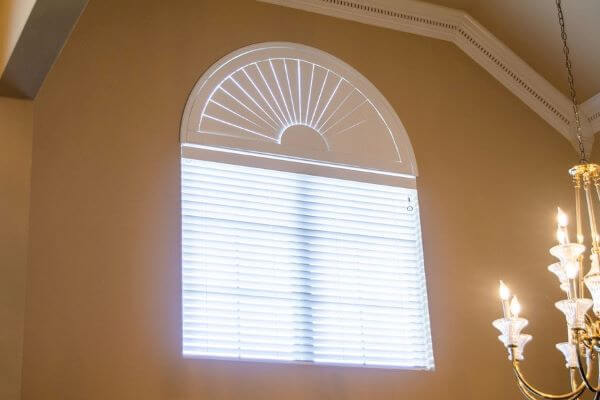
Railroading - when the width of the fabric becomes the length. Usually implemented to avoid seams. Typically used with sheers or fabrics with elaborate patterns.
Repeat - a measurement from one emblem or motif to the next in a pattern.
Return - the distance from the face of the head rail to the wall or frame. This is also the valance piece that attaches to the face of the valance to completely cover the headrail.
Return L Bracket - the bracket used to attach the returns to the face of the valance.
Right Stack - traversing drapes that open from the left side of the window and gather or “stack” on the right.
Right Stacking Vertical Blinds - an operational option for vertical blinds where the headrail is designed to allow the treatment to open from the left and stack to the right side of the window.
Rings - loops that attach to the fabric of the curtain or drape and slide over the rod or pole to allow the treatment to open and close.

Ripplefold Style Traversing Drapes - the pleating of this style of drapery is achieved by the spacing of the carriers. This pleating style is unique because both the front and the back of the finished product will look the same. This is also known as the “roll pleat” style.
Rod - typically adjustable with various options of styles and finishes to choose from. Rods can be smooth, reeded, or fluted to perform their various tasks.
Rod Face Width - the width of the rod needed should be determined by the width of the window plus an extension on either side (typically 7” per side). This width does not include the finials on each end.
Rod Mounted Valances - the material is attached to a decorative rod and mounted above the window. Mounting hardware is intended to be used as a decorative feature and not hidden or disguised.
Rod Pocket - an open-ended fabric sleeve where a curtain rod can be inserted. Sometimes also called a “casing.”
Rod Pocket Valance - a valance with a rod pocket, which will be based on the rod specifications. It is lined with standard lining except for sheers, casements, and lace, and banding or trim can be added at the bottom.
Roll Pleat Style Traversing Drapes - the pleating of this style of drapery is achieved by the spacing of the carriers. This pleating style is unique because both the front and the back of the finished product will look the same. This is also known as the “ripplefold pleat” style.
Roller Shades - a flat shade attached to a rolling mechanism that allows the treatment to extend down to cover a window or roll up to the casing at the top to expose the window. Roller shades can be made from vinyl, fabric, woven woods, mesh, or screen-like materials.
Roman Shades - a soft window treatment made from a piece of fabric or textile that evenly stacks as it is raised by a cord or a pull.
Room Darkening Window Treatments - window treatments are designed to keep out as much light as possible by providing 100% opacity (meaning no light will pass through the material). This does not mean that zero light will be able to enter the room through other means such as openings within the product or light gaps on the sides, but when the treatment is closed, the room will be noticeably darker.
Rosettes - window treatment hardware that is a decorative alternative to using a curtain rod. They are mounted directly to the wall above the window at evenly spaced intervals so that the material of the treatment can be draped over them and arranged. Also called “medallions.”
Route Hole - the punch in the slat that the lift cords run through.
Routeless Blinds - blinds that have notches cut in the front and back of each slat as opposed to having routed holes for the lift cords. This provides superior privacy and is better at blocking light rays that come through the routed holes. Also, each slat may be removed easily for cleaning.
R-value - a term used in building and construction to refer to how well a barrier resists the flow of heat. The higher the R-value, the greater the insulating property of that material.
S
Sash Curtains - curtain material hung between two sash rods, pulled taut, and mounted over a window. Allows light into the room while covering a portion of the window to add a level of privacy.
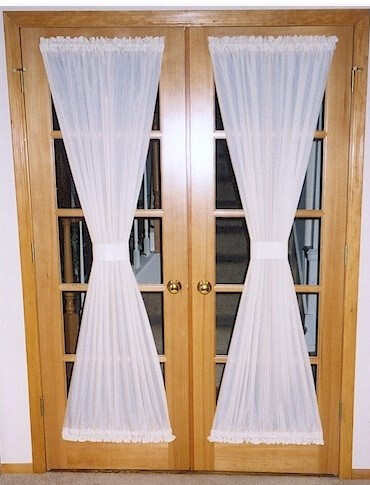
Scalloped Edge - a hem that features a repeating pattern that rises and falls at regular intervals.
Scarves - top treatments made from loose, free-flowing lengths of fabric that are slung or draped over a decorative rod. Not designed to hide the hardware but rather to enhance the look of it.
Seam Allowance - the extra length of fabric used to join two pieces together. Important to consider when measuring the finished product.
Selvage - the tightly woven edge of a piece of fabric designed to keep the fabric from fraying. Typically much sturdier than the rest of the piece, making it more challenging to sew through.
Sheers - a fabric panel made from translucent, see-through material such as chiffon or voile allowing some filtered light to pass through the fabric and into the room.
Shutters - a hard window treatment that has hinged or solid panels that may be folded across a window to diffuse light and add privacy. Shutters are also a great way to add architectural interest to a room and look great either painted or stained. Shutters have adjustable louvers that function in much the same way as Venetian blinds in that they may be opened to admit light and allow a partial view outside while maintaining a fair amount of privacy inside. Shutters with louvers that are over 2” wide are sometimes called “Plantation Shutters.”

Sill - the horizontal bottom portion of the window frame.
Single Hung Windows - windows where the top sash is fixed and the bottom sash is movable.
Single Width - refers to the finished width from selvage to selvage. Can be made from any length, but will gather to approximately 20.” The average width from selvage to selvage is 54.”
Slat - a thin piece of metal, wood, vinyl, or composite material strung together with ladder cords to make up horizontal blinds. The slats fit together or slightly overlap when the blind is in a closed position and are positioned flat and parallel in an open position.
Soft Window Treatments - window coverings that are made from soft materials such as textiles or fabric. The most common soft window treatments are drapes, curtains, sheers, Roman shades, valances, and swags.
Soft Fold With Ties Valance - a mock Roman-style valance with contrast or self-stirrups. Contrast welting is available with contrast stirrups and the number of pleats will depend on the length.
Solar Shades - a roller shade window treatment specifically designed to protect against UV rays.
Spacer/Projection Brackets - a 3/8” clear plastic spacer that is used on top or behind an installation bracket to clear obstructions.
Split Draw - traversing drapes that open from the center of the window. Also called a “center draw.”
Split Stack Vertical Blinds - an operational option for vertical blinds where the headrail is designed to allow the treatment to open in the center and stack on each side of the window.
Stacking Space - how much space the draperies will take up when they are open and in their drawn position.
Stagecoach Valance - a casual top treatment that gives the appearance of a roll-up shade typically with two vertical ties or bands that can be simple or embellished with decorative additions.
Standard Liner - the most commonly used liner and is standard on most shades and treatments typically made from polyester cotton.
Stationary - unmovable, stays in one position. An example of a stationary window treatment would be a decorative side panel.
Stop Ball - a circular piece that joins all of the lift cords as they come out of the headrail. It is used on all blinds to prevent the cords from tangling and to reduce the risk of possible strangulation.
Swag - a long side piece that attaches to the top treatment hardware to frame the upper portion of the window. These can be used by themselves or as a complementing feature to other top treatments.
T
Tab Top Curtains - a casual heading option that includes fabric loops spaced across the top of the curtain attaching it to the rod.

Tassel - attaches to the ends of cords to lift or tilt blinds, usually color coordinated. Tassels are wood on wood blinds, PVC on faux wood and wood Impressions, and plastic on metal and cellular shades.
Thermal Lining - an additional layer to your drapes or shades that add an extra level of protection against heat loss. Great for rooms where you want to keep a comfortable temperature all year long while staying energy efficient. For more information about how your window treatments can help with unnecessary energy loss, visit Window Treatments Could Save You Hundreds Each Month.
Tie-Backs - accessories used to hold back the sides of the curtain or drape in the open position. The height of the tie-back placement will determine how much of the window is exposed and how much light is let in. The general rule of thumb is to place the tie-back a third of the way from the top or a third of the way from the bottom.
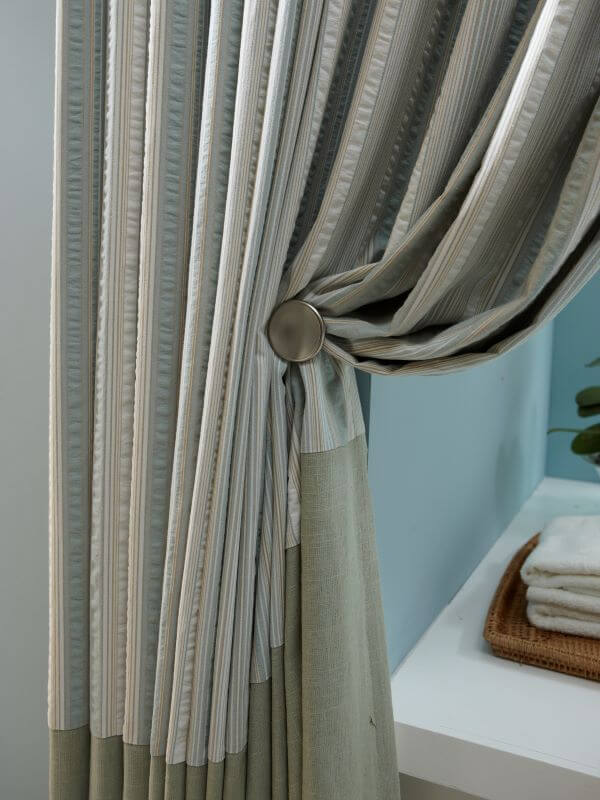
Tie Top Curtains - a casual heading option that uses ties at the top of the curtain to attach it to the rod.
Tier Curtains - a ruffled curtain hung in the middle of a window. Often coupled with a valance or a swag. Sometimes also called a “cafe curtain.”
Tilt Windows - a type of window that hinges from the bottom and opens from the top by tilting inwards. These windows are incredibly useful and energy efficient, but they can require certain considerations when it comes to adding window treatments.
Top Treatments - window treatments used at the top of the window to complete a look or styled effect. Popular top treatments include valances, cornices, scarves, and swags.
Transitional Shades - a window treatment that consists of two layers of fabric that rotate over each other where the stripes can give full privacy or give strips of transparency to see out. These are also called zebra shades.
Transom Windows - windows added above or to the side of a door. Typically rectangular and can be operable (able to be opened and closed) or fixed (nonoperable). The particular shape, location, and function of these windows may take some consideration when determining the right window treatment options.
Transparent - the quality of having 0% opacity or being completely see-through.
Traversing Drapes - functioning window treatments that can be opened and closed.
Trim - a great addition to soft window treatments to add a little more decoration and flair. Different types of trim include decorative tape, cording, fringe, and tassels.
V
Valance - a top treatment made from a section of fabric to decoratively cover the frame and hardware of other window treatments. Valances can also be used alone as a decorative feature for a window.
Valance Board - a decorative framework designed to conceal the rod and hardware at the top of a window.
Valance Clip - a clear plastic piece that is used to attach the valance to the head rail.
Valance Box - a decorative wooden top treatment mounted above a window which can be covered with fabric, paint, or wallpaper or can be designed and stained from an attractive piece of wood and remain uncovered. Sometimes these can also be upholstered, but they will not have any loose fabric hanging down. Also called a “cornice.”
Vane - a broad piece of metal, wood, vinyl, or composite material that hangs vertically from a track. The vanes fit together or slightly overlap when the vertical blind is in a closed position and are positioned parallel to one another in an open position.
Vertical Blinds - hard window treatments that use vertical vanes to cover a window. They are operable from side to side, stacking either to the right or left of the window, or they can split in the center and stack on each side (an operational option called a split stack). The slats are also operational and can louver open and shut usually by turning a control wand. The variety of options for different levels of coverage makes them very versatile and a great option for large-picture windows or sliding glass doors.
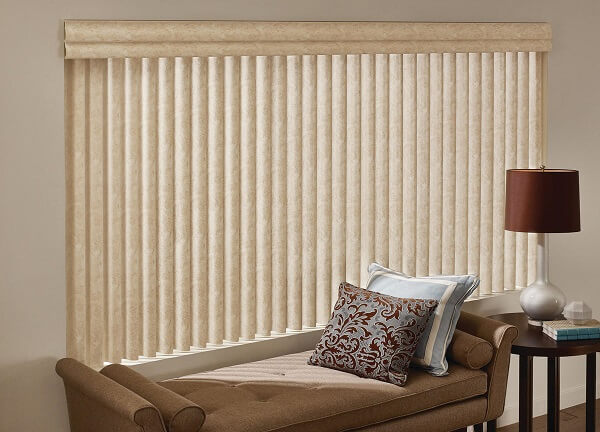
W
Wand Control - a long, slender control option for window treatments that does not use cords. Typically, the wand is connected to the leading side of the treatment to allow the treatment to open and close. The wand can also control the tilt of vanes or slats.
Wand Tilter - a component in the head rail that turns the slats up or down. Typically, a wand is attached to the tilter with a connector.
Water Repellent Liners - a cotton liner that is treated to help protect the drapery fabric from dust and moisture.
Window Casing - the decorative molding or trim around a window used to cover the space between the window frame or jamb and the wall.
Window Face Width - the width of the window measuring from inside the frame on the left to the right.
Window Frame - the outermost portion of the window. Also called the window casing. There are three main parts to the frame: the sill at the bottom, the jambs on the sides, and the head at the top.
Window Sash - the portion of a window that holds the glass and framework in place. The sash is fitted into the frame and may or may not be movable depending on the type of window.
Window Stack - the amount of the window that is exposed when a window treatment is opened to its maximum height or length.
Window Treatments - a covering or feature for a window that can be implemented for aesthetic enhancement or functionality (or both). They can be used to provide privacy, block out light or heat, or provide embellishment to a window.
Window Treatment Hardware - the pieces that mount your window treatment to the wall or window frame and allow it to hang and operate correctly. Typical hardware pieces include rods, rosettes, brackets, hooks, rings, clips, and finials. Learn more about the curtain hardware we offer.
Woven Wood Shades - a window covering that uses natural materials such as bamboo, jute, reeds, exotic grasses, and more, that are interwoven to create a mesh or screen-like covering. Depending on the tightness or openness of the weaving technique, these window treatments do have a certain level of opacity when a liner is not added. This type of product is incredibly popular for its natural and organic look.
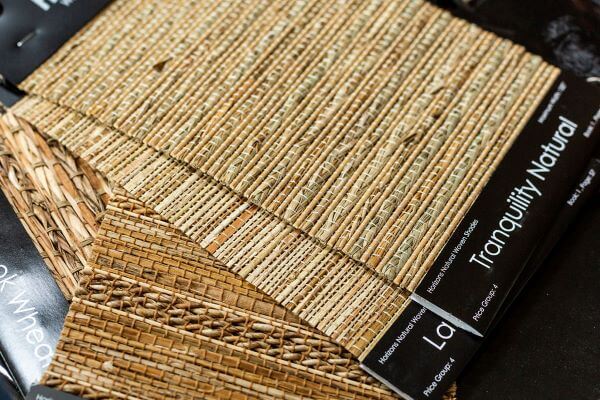
Z
Zebra Shades - a window treatment that consists of two layers of fabric that rotate over each other where the stripes can give full privacy or give strips of transparency to see out. These are also called transitional shades.
Conclusion
We hope this list is a helpful resource to give you an idea of what some of these commonly used window treatment terms and phrases mean. We know we are just barely scratching the surface of all the variations and possibilities when it comes to window treatment parts, options and accessories.
With thousands of custom window treatment options available, your Gotcha Covered Design Expert will be able to help you narrow down the choices to what will serve you best. Our goal is to find the perfect combination of window treatments and coverings to enhance your home or workplace.
Reach out to us today and see what our Gotcha Covered Design Team can do to bring style and flair to your windows! Call us at (888) 650-6187 or schedule a free design consultation today!





.2509031626052.png)